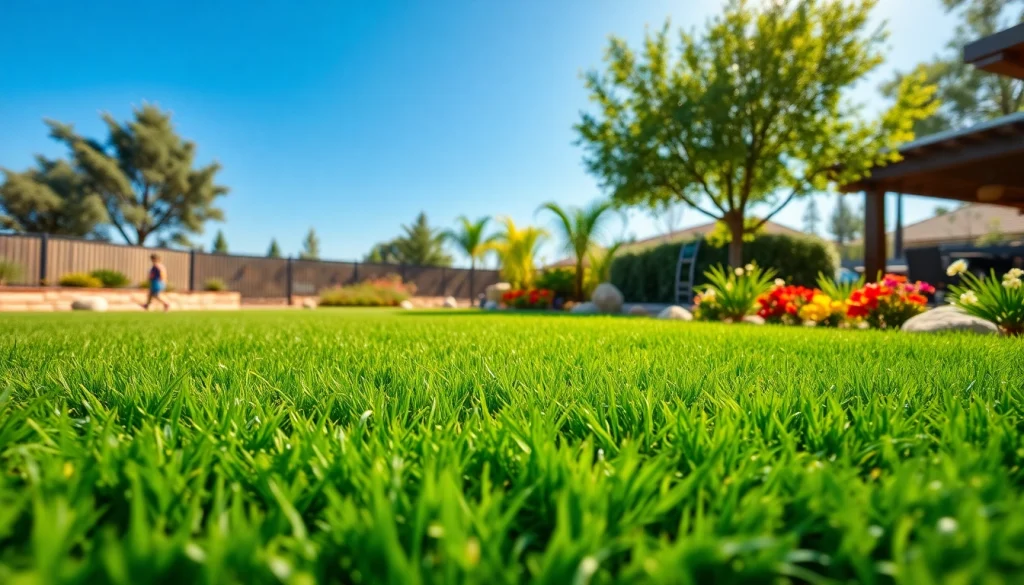Factors Affecting Turf Longevity
The lifespan of turf is a complex topic influenced by numerous factors. Understanding these elements is crucial for homeowners, landscapers, and property managers who wish to invest in quality turf and maximize its longevity. If you’re wondering how long does turf last, you need to look into several key factors.
Quality of Materials
The materials used in turf installation play a significant role in determining its lifespan. High-quality synthetic materials, such as polyethylene and nylon, are more durable and resistant to wear and tear compared to lower-grade options. Furthermore, the backing material and the density of the fibers can also impact how well turf can withstand heavy foot traffic and environmental stressors. For instance, turfs with reinforced backing systems provide better stability and prolonged lifespan.
In contrast, natural grass relies on the health of the soil and grass type. Choosing drought-resistant grass species or those suited for specific climates is essential for maintaining a lush lawn over the years. Seed quality and type can lead to varied outcomes in terms of resilience, maintenance needs, and longevity.
Installation Techniques
Proper installation is critical to how long turf lasts. For artificial turf, professional installation might involve a well-drained base composed of crushed rock or gravel to ensure proper drainage, preventing water accumulation that can damage the structure over time. When turf is installed to the manufacturer’s specifications, it is less prone to issues such as wrinkling, shifting, or pooling of water, all of which can shorten the turf’s lifespan.
Similarly, with natural grass, the method of laying sod or seeding considerably affects growth. Steps like soil testing for pH balance, aeration, and ensuring appropriate seed-to-soil contact can lead to healthier roots and a thicker, more resilient lawn.
Climate and Environmental Conditions
The local climate can significantly influence turf durability. For natural grass, factors like temperature, rainfall, and sunlight exposure play pivotal roles in its growth and survival. Regions with extreme heat or cold may require specific grass varieties tailored for those conditions.
Artificial turf, while generally more resistant to environmental extremes, is not without its vulnerabilities. Prolonged exposure to UV rays can cause fading, while extreme temperatures can impact its texture and feel. Additionally, the geographic location can influence how much maintenance and care synthetic turf requires to ensure it does not become overly hot or degrade.
Typical Lifespan of Different Turf Types
The life expectancy of turf varies significantly between natural grass and artificial options, and even among different types of turf within these categories.
Natural Grass vs. Artificial Turf
Natural grass typically has a lifespan of approximately 5 to 10 years, depending on the variety and maintenance regime. Factors such as soil quality, watering and fertilization practices, and local climate will dictate how lush and healthy a natural lawn remains over its life.
On the other hand, high-quality artificial turf can last anywhere from 15 to 25 years. This is largely due to advancements in manufacturing processes, which have led to the production of more resilient fibers and backing systems. However, regular maintenance, including cleaning and occasional infill replenishment, is necessary to keep synthetic turf looking fresh and functional for its full lifespan.
Variations Among Artificial Turf Types
Artificial turf comes in different types, each designed for specific uses—from sports fields to residential lawns. For example, turf designed for sports may enhance durability and shock absorption, while residential turf emphasizes aesthetics and comfort underfoot. The material composition, fiber density, and intended purpose can lead to significant variations in lifespan. Overall, while selecting turf type, understanding its primary application and durability features will result in a well-informed decision that maximizes lifespan.
Regional Differences in Turf Lifespan
Not all regions are created equal when it comes to turf longevity. For instance, southern states with abundant sunshine may see a decline in natural grass due to heat stress, while northern areas cope with challenges posed by frost and snow. Understanding these regional differences is essential when selecting the appropriate turf type for your location. Choosing drought-resistant varieties in arid regions or shades of grass that flourish in humidity can significantly impact overall turf health and lifespan.
Signs of Turf Aging and Decline
Visual Indicators of Wear
Both natural and artificial turfs exhibit distinct visual signs when they begin to age or deteriorate. For natural grass, thinning patches, discoloration, and increased susceptibility to weeds are clear indicators that the lawn is struggling. These symptoms may suggest that the soil is depleted or the turf is not receiving adequate care.
Artificial turf, while more resilient, isn’t immune to wear. Look for fraying fibers, loss of color, and substantiation in high-traffic areas. These visual cues often indicate the need for repair or maintenance measures to restore the turf’s condition.
Performance Metrics
While visual cues can provide an initial warning, understanding performance metrics will give a more quantitative assessment of turf condition. For natural grass, measuring grass height, leaf density, and soil moisture can help determine if the turf is thriving or struggling. Regularly assessing these metrics can help catch issues early on before they lead to significant loss.
In the case of artificial turf, examining performance factors like drainage effectiveness, cushioning resilience, and overall aesthetics will offer further insight into the turf’s condition. Pay attention to how the turf feels underfoot; a hard or uneven surface can signal that maintenance is overdue.
Maintenance Factors Impacting Lifespan
Maintenance practices are perhaps the most influential factors in determining how long turf lasts. For natural grass, regular mowing, adequate watering, overseeding, and fertilizing contribute significantly to turf health. Sustainable practices like aeration can improve root establishment, which results in a healthier lawn.
Artificial turf requires different maintenance. Regular cleaning to remove dirt and debris is essential, as is periodic brushing to keep fibers standing upright. Monitoring infill levels can ensure the turf maintains proper cushioning and support. Implementing these practices will help prevent premature signs of aging and maintain the integrity of the turf.
Best Practices for Extending Turf Life
When it comes to prolonging the life of turf, it pays to be proactive rather than reactive. There exist numerous best practices tailored to both natural and artificial turf which, if implemented effectively, will yield significant results.
Regular Maintenance Techniques
For natural grass, regular mowing promotes healthier grass; maintaining a height appropriate for the specific type of grass can control weeds and improve sunlight penetration. Additionally, ensuring the lawn receives consistent moisture without overwatering is critical—striking a balance can lead to deep rooting and drought resistance.
In the case of artificial turf, maintain flat surfaces and effective drainage by routinely brushing the fibers. Cleaning spills immediately and scheduling biannual deep-cleaning sessions will help in sustaining the turf’s visual and functional appeal.
Seasonal Care Tips
Seasonal changes require adjustments in care routines. During the spring, natural grass may benefit from fertilization and aeration to encourage growth, while protecting it from summer heat can mean adjusting watering practices and applying shade cover where needed. In fall, overseeding can rejuvenate the lawn heading into winter.
Conversely, prepare artificial turf for winter by ensuring drainage is functioning correctly. Storing patio furniture to reduce compression on turf and managing debris accumulation will help maintain its condition throughout colder months.
Choosing the Right Products
The products used for turf maintenance can enhance or undermine longevity. For natural grass, selecting high-quality fertilizers and pest control products designed for specific grass types can yield superior results. Ensure these products are eco-friendly whenever possible to protect your lawn and surrounding environment.
For artificial turf, consider investing in specialized cleaning supplies formulated specifically for synthetic materials. Avoid harsh chemicals that can degrade fibers or backing materials, and utilize products that protect against UV exposure as well.
Making an Informed Decision About Turf
With a myriad of options available, making informed choices about turf requires thoughtful consideration and analysis. Understanding both financial implications and the care required can ensure your investment is well-spent.
Cost-Benefit Analysis of Turf Types
When evaluating turf types, it’s essential to perform a cost-benefit analysis that assesses the upfront costs of installation against long-term maintenance expenses. Natural grass may appear less expensive initially, but ongoing water, fertilization, and pest management costs can add up. In contrast, while artificial turf has a higher upfront cost, its lower maintenance costs and longevity may yield significant savings over time.
Long-Term Investment Considerations
Consider the long-term impact of turf installation on property value, utility costs, and maintenance labor. Landscaping plays a crucial role in property aesthetics and value, and turf can enhance curb appeal significantly. Choosing high-quality turf that meets current and anticipated needs will maximize your property’s investment return.
Consulting Professionals for Guidance
In many cases, consulting with landscape professionals can provide valuable insights tailored to individual circumstances or regional considerations. Professionals can offer recommendations based on experience and local standards, helping to align turf selection with preservation strategies that will yield longevity and visual appeal.


